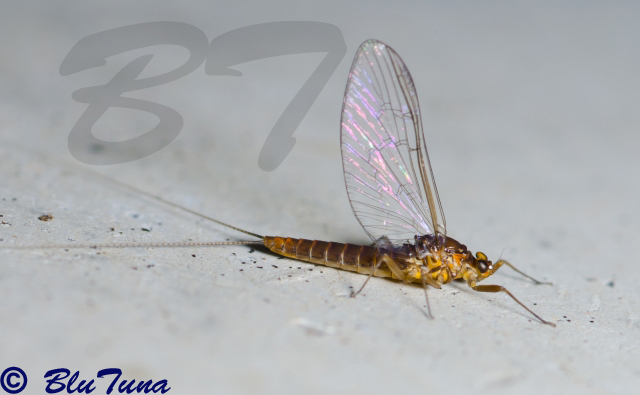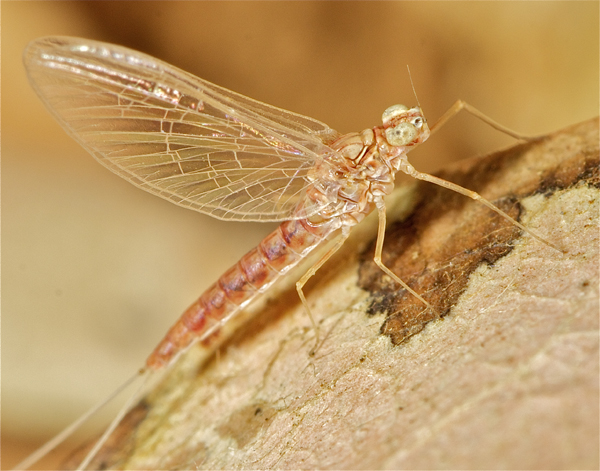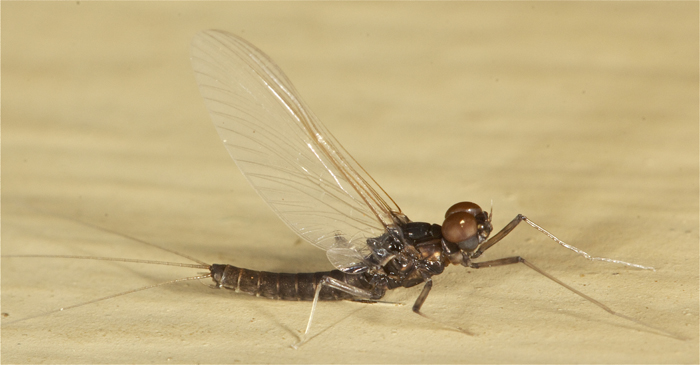Africa Wild Insect Book: Mayflies (Order Ephemeroptera)
Upload your picture of a mayfly and add a description underneath. Please only do one species per post.
All entries will be edited and updated (additional photos and information will be added by moderators). New entries will be posted according to taxonomic order and the post date does not reflect the actual date of new posts.
AW Insect Book: Mayflies Ephemeroptera Pics & Description
Moderator: Klipspringer
Re: AW Insect Book: Mayflies Ephemeroptera Pics & Descriptio
Index to Mayflies (Order Ephemeroptera)
Order: EPHEMEROPTERA
Suborder: Carapacea
Prosopistomatidae
Suborder: Furcatergalia
Superfamily: Leptophlebioidea
Leptophlebiidae (Prong-gill Mayflies)
Euthrualus sp. Common Prongill viewtopic.php?p=488340#p488340
Superfamily: Ephemeroidea
Polymitarcyidae
Ephemeridae
Superfamily: Caenoidea
Caenidae
Superfamily: Ephemerelloidea
Teloganodidae
Machadorythidae
Tricorythidae
Suborder: Setisura
Superfamily: Heptagenioidea
Oligoneuriidae
Heptageniidae (Flat-headed Mayflies)
Notonurus bequaerti Flat-head Mayfly viewtopic.php?p=488641#p488641
Suborder: Pisciforma
Superfamily: Siphlonuroidea
Baetidae (Small Minnow Mayflies)
Cloeon sp. Double-gilled Pond Creeper viewtopic.php?p=488335#p488335
Order: EPHEMEROPTERA
Suborder: Carapacea
Prosopistomatidae
Suborder: Furcatergalia
Superfamily: Leptophlebioidea
Leptophlebiidae (Prong-gill Mayflies)
Euthrualus sp. Common Prongill viewtopic.php?p=488340#p488340
Superfamily: Ephemeroidea
Polymitarcyidae
Ephemeridae
Superfamily: Caenoidea
Caenidae
Superfamily: Ephemerelloidea
Teloganodidae
Machadorythidae
Tricorythidae
Suborder: Setisura
Superfamily: Heptagenioidea
Oligoneuriidae
Heptageniidae (Flat-headed Mayflies)
Notonurus bequaerti Flat-head Mayfly viewtopic.php?p=488641#p488641
Suborder: Pisciforma
Superfamily: Siphlonuroidea
Baetidae (Small Minnow Mayflies)
Cloeon sp. Double-gilled Pond Creeper viewtopic.php?p=488335#p488335
Re: AW Insect Book: Mayflies Ephemeroptera Pics & Descriptio
Adult mayflies are very short-lived, typically only living about a day. They do not feed in the adult stage so as soon as the adult female emerges, she needs to mate and lay her eggs as soon as possible. Mating takes place in swarms, typically over water but also sometimes over a prominent landmark near the water. Males fly up and down in the swarm and mating takes place in flight. Eggs are laid in the water, usually by depositing them in flight although there are species which crawl into the water and lay their eggs on the bottom of the water body. Nymphs are aquatic and in most species feed on detritus and algae on the bottom of the stream although there are carnivorous and filter-feeding species as well. Mayflies are unique among insects in having a winged subimago stage which then moults into the winged imago (adult) stage. In other insects there is no more moulting after they have moulted into a stage with functional wings.
All mayfly nymphs are characterised by an elongated body, large head, well-developed mouthparts and stout legs. Paired gills on the abdomen are the most characteristic feature to distinguish mayfly nymphs from other insects. These gills vary greatly, they can be typically leaf-like, oval or even fringed. Three tails are always present, except in the family Baetidae where some species only have two tails. The Prosopistomatidae does not match the characteristics as described above. Prosopistomatidae nymphs has flat, oval bodies with no visible gills and a short stubby tail.
Fully developed nymphs will only come to the surface when they are ready to transform in which case the outer skin is shed and the first adult stage emerges.
This adult (subimago) will sit undisturbed on vegetation for anything from a few minutes to 24 hours until another layer is shed and the final adult (imago) emerges.
Identification:
Delicate, weak-flying insects with 2 or 3 long 'tails' at hind end. Front legs very long, especially in males, which can be recognised by a pair of claspers at the hind end. Usually 2 pairs of wings with complex venation: hind pair always much smaller than forewings and sometimes missing. Wings held vertically above body at rest or partly open: cannot be folded back along the body. Antennae minute. Eyes larger in male than in female and sometimes much expanded to form turrets well above the rest of the head (turbinate condition). Adults do not feed. Mainly crepuscular or nocturnal and rarely found far from the water in which they grow up.
All mayfly nymphs are characterised by an elongated body, large head, well-developed mouthparts and stout legs. Paired gills on the abdomen are the most characteristic feature to distinguish mayfly nymphs from other insects. These gills vary greatly, they can be typically leaf-like, oval or even fringed. Three tails are always present, except in the family Baetidae where some species only have two tails. The Prosopistomatidae does not match the characteristics as described above. Prosopistomatidae nymphs has flat, oval bodies with no visible gills and a short stubby tail.
Fully developed nymphs will only come to the surface when they are ready to transform in which case the outer skin is shed and the first adult stage emerges.
This adult (subimago) will sit undisturbed on vegetation for anything from a few minutes to 24 hours until another layer is shed and the final adult (imago) emerges.
Identification:
Delicate, weak-flying insects with 2 or 3 long 'tails' at hind end. Front legs very long, especially in males, which can be recognised by a pair of claspers at the hind end. Usually 2 pairs of wings with complex venation: hind pair always much smaller than forewings and sometimes missing. Wings held vertically above body at rest or partly open: cannot be folded back along the body. Antennae minute. Eyes larger in male than in female and sometimes much expanded to form turrets well above the rest of the head (turbinate condition). Adults do not feed. Mainly crepuscular or nocturnal and rarely found far from the water in which they grow up.
Re: Index to Africa Wild Insect & Invertebratae Books
Small Minnow Mayfly
Family: Baetidae
 © BluTuna
© BluTuna
Garden in Johannesburg
Baetidae is a family of mayflies with about 900 described species distributed worldwide. These are among the smallest of mayflies, adults rarely exceeding 10 mm in length excluding the two long slender tails and sometimes much smaller, and members of the family are often referred to as small mayflies or small minnow mayflies. Most species have long oval forewings with very few cross veins but the hindwings are usually very small or even absent. The males often have very large eyes, shaped like turrets above the head.
Links: Checklist: The Baetid Mayflies (Ephemeroptera: Baetidae) of South Africa
Family: Baetidae
 © BluTuna
© BluTunaGarden in Johannesburg
Baetidae is a family of mayflies with about 900 described species distributed worldwide. These are among the smallest of mayflies, adults rarely exceeding 10 mm in length excluding the two long slender tails and sometimes much smaller, and members of the family are often referred to as small mayflies or small minnow mayflies. Most species have long oval forewings with very few cross veins but the hindwings are usually very small or even absent. The males often have very large eyes, shaped like turrets above the head.
Links: Checklist: The Baetid Mayflies (Ephemeroptera: Baetidae) of South Africa
Hunting cannot be considered a sport as all contestants in a sport should know they are playing the game!
-
Klipspringer
- Global Moderator
- Posts: 5862
- Joined: Sat Sep 14, 2013 12:34 pm
- Country: Germany
- Contact:
Mayflies of the Kruger National Park
According to a data set based on detailed series of surveys of the freshwater macro-invertebrate fauna of selected rivers within the Kruger National Park by Dr. Helen James the following Mayfly species are found in the KNP:
Baetidae
Acanthiops varius
Afrobaetodes berneri
Afroptilum sp.
Afroptilum sudafricanum
Baetis harrisoni
Bugilliesia margaretae
Centroptiloides sp.
Centroptiloides bifasciata
Cheleocloeon sp.
Cheleocloeon excisum
Cloeodes sp.
Cloeon sp.
Crassabwa sp.
Crassabwa flava
Dabulamanzia fica
Dabulamanzia helenae
Dabulamanzia media
Demoulinia crassi
Demoreptus sp.
Dicentroptilum spinulosum
Nigrobaetis bethunae
Procloeon sp.
Pseudocloeon glaucum
Pseudocloeon latum
Pseudocloeon piscis
Pseudocloeon vinosum
Pseudopannota camerunense
Pseudopannota maculosa
Caenidae
Caenis sp.
Heptageniidae
Afronurus peringueyi
Notonurus bequaerti
Leptophlebiidae
Adenophlebia sp.
Euthraulus sp.
Euthraulus elegans
Hyalophlebia sp.
Hyalophlebia patriciae
Machadorythidae
Machadorythus sp.
Oligoneuriidae
Elassoneuria trimeniana
Polymitarcyidae
Ephoron savignyi
Prosopistomatidae
Prosopistoma mccaffertyi
Tricorythidae
Tricorythus sp.
Tricorythus discolor
Tricorythus reticulatus
Tricorythus tener
Links:
http://fbip.co.za/wp-content/uploads/20 ... _S_v2.xlsx
Baetidae
Acanthiops varius
Afrobaetodes berneri
Afroptilum sp.
Afroptilum sudafricanum
Baetis harrisoni
Bugilliesia margaretae
Centroptiloides sp.
Centroptiloides bifasciata
Cheleocloeon sp.
Cheleocloeon excisum
Cloeodes sp.
Cloeon sp.
Crassabwa sp.
Crassabwa flava
Dabulamanzia fica
Dabulamanzia helenae
Dabulamanzia media
Demoulinia crassi
Demoreptus sp.
Dicentroptilum spinulosum
Nigrobaetis bethunae
Procloeon sp.
Pseudocloeon glaucum
Pseudocloeon latum
Pseudocloeon piscis
Pseudocloeon vinosum
Pseudopannota camerunense
Pseudopannota maculosa
Caenidae
Caenis sp.
Heptageniidae
Afronurus peringueyi
Notonurus bequaerti
Leptophlebiidae
Adenophlebia sp.
Euthraulus sp.
Euthraulus elegans
Hyalophlebia sp.
Hyalophlebia patriciae
Machadorythidae
Machadorythus sp.
Oligoneuriidae
Elassoneuria trimeniana
Polymitarcyidae
Ephoron savignyi
Prosopistomatidae
Prosopistoma mccaffertyi
Tricorythidae
Tricorythus sp.
Tricorythus discolor
Tricorythus reticulatus
Tricorythus tener
Links:
http://fbip.co.za/wp-content/uploads/20 ... _S_v2.xlsx
-
Klipspringer
- Global Moderator
- Posts: 5862
- Joined: Sat Sep 14, 2013 12:34 pm
- Country: Germany
- Contact:
Re: AW Insect Book: Mayflies Ephemeroptera Pics & Description
Baetidae: Small Minnow Mayflies
Introduction
In 1815, Leach divided the tribe Ephemerides into two families, depending on the number of caudal filaments in the imaginal stage. He established the family Baetidae for species with two caudal filaments and the Ephemeridae for species with three filaments. In the Baetidae, he established two genera: Baetis for species with four wings and Cloeon for species with two wings. In the last 200 years, the systematics of the Baetidae has greatly improved, and this family now encompasses about 100 genera and 900 species which constitute one-quarter of the world’s mayfly diversity. Except for Antarctica and New Zealand, Baetidae present a cosmopolitan distribution.
Baetidae constitute a relatively homogenous family. They are distinguished in the imaginal stage by the presence of turbinate eyes in the male imago, detached IMA and MA 2 forewing veins, the presence of simple or double free intercalary veins in the forewing (partially or completely reduced in a few taxa), hind wing reduced or absent, three-segmented mid and hind tarsi and membranous penis.
The prominent turbinate eyes of males, especially well-developed in the Baetidae and some Leptophlebiidae, provide both high acuity and good sensitivity. This enables them to detect and capture single females in a swarm at low light intensities.
Links:
https://www.researchgate.net/publicatio ... emeroptera
https://www.ru.ac.za/media/rhodesuniver ... tidae.html
https://books.google.de/books?id=5Q1bDw ... ts&f=false
Introduction
In 1815, Leach divided the tribe Ephemerides into two families, depending on the number of caudal filaments in the imaginal stage. He established the family Baetidae for species with two caudal filaments and the Ephemeridae for species with three filaments. In the Baetidae, he established two genera: Baetis for species with four wings and Cloeon for species with two wings. In the last 200 years, the systematics of the Baetidae has greatly improved, and this family now encompasses about 100 genera and 900 species which constitute one-quarter of the world’s mayfly diversity. Except for Antarctica and New Zealand, Baetidae present a cosmopolitan distribution.
Baetidae constitute a relatively homogenous family. They are distinguished in the imaginal stage by the presence of turbinate eyes in the male imago, detached IMA and MA 2 forewing veins, the presence of simple or double free intercalary veins in the forewing (partially or completely reduced in a few taxa), hind wing reduced or absent, three-segmented mid and hind tarsi and membranous penis.
The prominent turbinate eyes of males, especially well-developed in the Baetidae and some Leptophlebiidae, provide both high acuity and good sensitivity. This enables them to detect and capture single females in a swarm at low light intensities.
Links:
https://www.researchgate.net/publicatio ... emeroptera
https://www.ru.ac.za/media/rhodesuniver ... tidae.html
https://books.google.de/books?id=5Q1bDw ... ts&f=false
-
Klipspringer
- Global Moderator
- Posts: 5862
- Joined: Sat Sep 14, 2013 12:34 pm
- Country: Germany
- Contact:
Re: AW Insect Book: Mayflies Ephemeroptera Pics & Description
Double-gilled Pond Creeper Cloeon sp.
Family Baetidae

Kruger National Park © ExFmem, identified by Dr. Helen James
Ten species known in southern Africa.
Nymphs usually have rounded double gills on segments 2–6 or 1–5 (depending on species). Claws relatively long, with tiny teeth in the basal third.
Nymphs found in pools, backwaters or temporary water bodies, often among vegetation.
In both sexes hindwings absent and forewings have single marginal intercalaries. Adults with two caudal filaments. Size: Body 3–7.5mm in length. Adults emerge in open water, away from the shore; eggs are laid on the water surface at dusk. Some species ovoviviparous. Females retreat to a secluded place until eggs are ready to hatch.
Family Baetidae

Kruger National Park © ExFmem, identified by Dr. Helen James
Ten species known in southern Africa.
Nymphs usually have rounded double gills on segments 2–6 or 1–5 (depending on species). Claws relatively long, with tiny teeth in the basal third.
Nymphs found in pools, backwaters or temporary water bodies, often among vegetation.
In both sexes hindwings absent and forewings have single marginal intercalaries. Adults with two caudal filaments. Size: Body 3–7.5mm in length. Adults emerge in open water, away from the shore; eggs are laid on the water surface at dusk. Some species ovoviviparous. Females retreat to a secluded place until eggs are ready to hatch.
-
Klipspringer
- Global Moderator
- Posts: 5862
- Joined: Sat Sep 14, 2013 12:34 pm
- Country: Germany
- Contact:
-
Klipspringer
- Global Moderator
- Posts: 5862
- Joined: Sat Sep 14, 2013 12:34 pm
- Country: Germany
- Contact:
Re: AW Insect Book: Mayflies Ephemeroptera Pics & Description
Common Prongill Euthrualus sp.
Family: Leptophlebiidae

Kruger National Park © ExFmem, identified by Dr. Helen James
Widespread in Africa, with only one species (E. elegans) currently described in South Africa but others recognised.
Nymphs a nondescript dark brown colour, with gill 1 a single long filament and gills 2–7 double, with three slender filaments at their tips. Claws with small teeth growing progressively larger towards apex.
Nymphs prefer slow-flowing waters.
In adults, spur of hindwing is covered with small scales. Size: Body 7–8mm in length
Adults fly in summer, emerging from the water surface at night.
Links:
https://www.researchgate.net/publicatio ... emeroptera
https://books.google.de/books?id=kw9bDw ... ed&f=false
https://www.ru.ac.za/media/rhodesuniver ... iidae.html
Family: Leptophlebiidae

Kruger National Park © ExFmem, identified by Dr. Helen James
Widespread in Africa, with only one species (E. elegans) currently described in South Africa but others recognised.
Nymphs a nondescript dark brown colour, with gill 1 a single long filament and gills 2–7 double, with three slender filaments at their tips. Claws with small teeth growing progressively larger towards apex.
Nymphs prefer slow-flowing waters.
In adults, spur of hindwing is covered with small scales. Size: Body 7–8mm in length
Adults fly in summer, emerging from the water surface at night.
Links:
https://www.researchgate.net/publicatio ... emeroptera
https://books.google.de/books?id=kw9bDw ... ed&f=false
https://www.ru.ac.za/media/rhodesuniver ... iidae.html
-
Klipspringer
- Global Moderator
- Posts: 5862
- Joined: Sat Sep 14, 2013 12:34 pm
- Country: Germany
- Contact:
Re: AW Insect Book: Mayflies Ephemeroptera Pics & Description
Heptageniidae: Flat-head Mayflies
The Heptageniidae (synonym: Ecdyonuridae) are a family of rather small mayflies with three long tails. The wings are usually clear with prominent venation although species with variegated wings are known. As in most mayflies, the males have large compound eyes, but not divided into upper and lower parts.
Links:
https://www.researchgate.net/publicatio ... emeroptera
https://www.ru.ac.za/media/rhodesuniver ... iidae.html
https://books.google.de/books?id=kw9bDw ... ed&f=false
The Heptageniidae (synonym: Ecdyonuridae) are a family of rather small mayflies with three long tails. The wings are usually clear with prominent venation although species with variegated wings are known. As in most mayflies, the males have large compound eyes, but not divided into upper and lower parts.
Links:
https://www.researchgate.net/publicatio ... emeroptera
https://www.ru.ac.za/media/rhodesuniver ... iidae.html
https://books.google.de/books?id=kw9bDw ... ed&f=false


